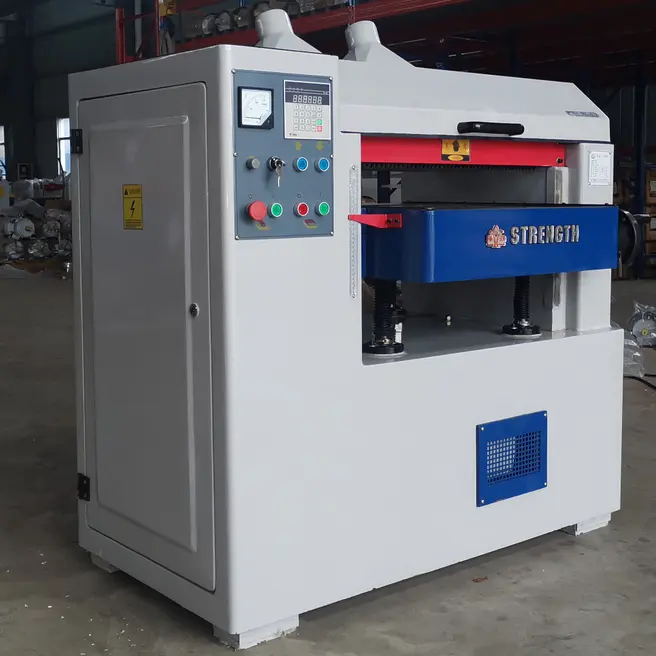What safety equipment do you need to check before operating a double-end planer?
Introduction
The double-end planer is a widely used mechanical equipment in the wood processing industry, which can efficiently plan and shape wood. However, due to its high-speed running tool and complex mechanical structure, if it is not operated properly, it may cause serious safety accidents. Therefore, it is crucial to conduct a comprehensive inspection of the relevant safety equipment before operating the double-end planer. This article will introduce in detail the safety equipment that needs to be checked before operating the double-end planer to ensure the safety of the operator and the normal operation of the equipment.
1. Personal protective equipment
Safety glasses
Operators must wear safety glasses that meet the standards to prevent wood chips, fragments or other foreign objects from entering the eyes and causing injuries.
Protective gloves
Protective gloves can protect the hands from sharp wood edges, tool fragments and possible mechanical squeeze injuries.
Protective shoes
Protective shoes can prevent falling wood or tools from causing damage to the feet, while providing a stable standing base.
Earplugs or earmuffs
Since the planer will generate high noise when running, wearing earplugs or earmuffs can effectively protect hearing and prevent hearing damage caused by noise pollution.
2. Electrical system
Power cord inspection
Check whether the power cord is damaged, aged or exposed, and ensure that the insulation layer of the power cord is intact to prevent electric shock accidents.
Grounding inspection
Ensure that the planer is well grounded, and the grounding resistance should meet relevant safety standards to prevent equipment leakage.
Emergency stop button
Check whether the emergency stop button is sensitive and reliable, and can quickly cut off the power supply and stop the equipment in an emergency.
3. Protective device
Rebound plate
Check whether the rebound plate is lowered and fixed firmly. The rebound plate can prevent the wood from rebounding during the planing process and avoid harm to the operator.
Tool guard
Ensure that the tool guard is installed correctly and without damage. The guard can cover the knife shaft to prevent the operator from accidentally contacting the high-speed rotating tool.
Workbench guardrail
If the workbench or workpiece of the planer extends too long, a guardrail should be set to prevent people from approaching the dangerous area when the equipment is running.
4. Tool inspection
Blade fixing
Check whether each blade is firmly installed, ensure that the distance between the blade and the knife holder is equal, and the blade weld is free of cracks or damage.
Blade sharpness
The blade should be kept sharp, and the wear of the blade should be checked regularly. Damaged or severely worn blades should be replaced in time to ensure the planing effect and safe operation.
5. Lubrication system
Lubricating oil inspection
Check whether the oil volume of each lubrication part is sufficient and the oil quality is good to ensure smooth operation of the equipment and reduce mechanical wear.
Oil circuit inspection
Ensure that the oil circuit is unobstructed and there is no leakage. Clean the oil pipes, oil holes and other components regularly to keep the lubrication system clean.
6. Working environment
Workbench cleaning
Clean obstacles and debris on the workbench before operation to ensure that the workbench surface is flat and tidy to prevent the wood from shifting or getting stuck during processing.
Wood inspection
Check whether there are hard debris such as nails and stones on the wood to be processed. If so, it should be removed before processing to avoid damage to the tool or safety accidents.
VII. Other safety inspections
No-load test run
Before formal processing, conduct a 1-2 minute no-load test run to observe whether the various indicators of the equipment are normal, such as tool speed, conveyor chain operation, etc., to ensure that the equipment is normal before processing.
Safety signs
Ensure that obvious safety warning signs are set around the equipment to remind operators and other personnel to pay attention to safety.
Conclusion
As a high-precision and high-efficiency woodworking equipment, the double-end planer brings convenience but also brings certain safety risks. By conducting a comprehensive and detailed inspection of personal protective equipment, electrical systems, protective devices, tools, lubrication systems, working environment and other related safety equipment before operation, the occurrence of safety accidents can be effectively prevented and reduced, and the personal safety of operators and the normal operation of equipment can be guaranteed. For enterprises and individuals engaged in the wood processing industry, paying attention to the inspection and maintenance of safety equipment is an important guarantee for ensuring production safety and improving work efficiency.
Post time: Apr-04-2025

